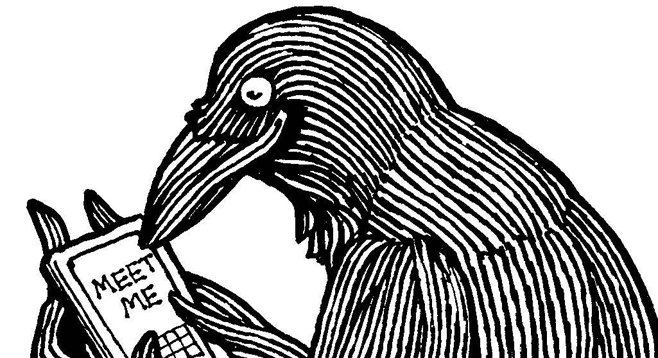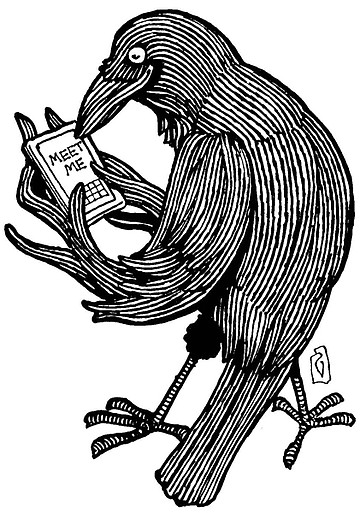 Facebook
Facebook
 X
X
 Instagram
Instagram
 TikTok
TikTok
 Youtube
Youtube

Heymatt:
Last September you said that ravens go “somewhere” at the end of the day to go over the day’s events, or something to that effect. I live in Spring Valley and at sunup I see thousands of them flying to the northeast. At sundown, they all fly to the southwest to spend the night. I see a few of them around various places eating roadkill and olives or dive-bombing hawks, but the majority seem to be going someplace specific. Have you ever tracked them to find out exactly where they spend the day and then the night? I depend on you to solve this mystery.
— Langston, Spring Valley

Having dispatched the elves to follow the birds from dawn ’til dusk, I can report two things:
Firstly, those aren’t ravens you’re seeing, they’re crows. The two birds are similar and hard to differentiate, especially when concentrated in big flocks. The main difference is that crows go for cheap shots nine times out of ten, which some of the elves found out the hard way. It turns out crows will heckle elves whereas ravens take the high road. Also, crows are smaller. Both birds are genetically passerines (songbirds) and more closely related to sparrows and wrens than to big birds such as hawks or vultures. If you could imagine expanding a chickadee to one hundred times its normal size, it would end up looking a lot like a raven.
Secondly, the crows are headed to a roost along the Sweetwater River adjacent to the Plaza Bonita Shopping Center and east of the 805. Between five and six thousand of them sleep there, especially outside the breeding season. There is another roost out by Lake Hodges and new ones are starting to appear as the birds, which were nearly non-existent around San Diego until the mid-1980s, increase in population and have to seek out new habitats. During the day, they disperse throughout the area so as not to be in competition with each other for the available resources.
Heymatt:
I was at Mission Beach and as the sun went down when two large fishing boats showed up not far from the beach. It looked like they were trawling. If so, what’s the deal?
— Tena
“Trawling,” by which we mean dragging a weighted net along the bottom of the ocean to scoop up bottom-dwelling fish, is not permitted in California’s state waters; meaning everything within a 12-mile radius of the California shoreline. Even out past that distance, where ground fishing is allowed, government regulators from National Marine Fisheries enforce strict guidelines on equipment and fishing practices. Those fishing boats that have been steaming around just off San Diego shores are one of two kinds of squid boat. First, light boats come along and beam lanterns down into the water. Squid (being intelligent in some ways and very dumb in others) swarm like little, aquatic moths to the lights. Once they’re all collected at the surface, other boats come by with purse-seine nets and scoop up the squid en masse. Since the squid spawn over sand and are fished from the surface, the purse seiners don’t cause the damage associated with trawling; i.e., bycatch (catching the wrong fish) and damage to habitat as the net drags along the ground. Considering that the U.S. imports 80 percent of its seafood, seeing Californian boats sustainably fishing a stable population of squid is a pretty good thing. If you want to get your hands on some of those squid, or other local fish, try Catalina Offshore Products right here in town.
Heymatt:
I’m wondering if you know the origin of the word “toots” when used as an old-fashioned nickname for a woman, which I guess means something like “baby” or “doll” and pronounced to rhyme with “puts.” Does it come from “Toot-Toot-Tootsie Roll”? It doesn’t have anything to do with “tooting,” does it?
— Donna, via email
Calling a woman “toots” has the undeniable flavor of the Roaring Twenties, but it doesn’t appear in common usage until the mid-’30s. Despite the fact that the chocolate Tootsie Roll was invented in 1896 and trademarked in 1925, it’s unlikely that “toots” comes from the candy. Our best guess is that it’s an evolution of “tootsy-wootsy,” which was in use from the late 19th Century onward to mean “sweetie,” or anything to that effect. Early uses of “tootsy” are all actually in reference to feet, perhaps evocative of babytalk or rhyming with “footsy,” and it’s unclear how it changed to mean “sweetie.” “Toots,” as opposed to “tootsie,” is a bit derogatory; the kind of thing a gangster says to a floozie, not a sweet nothing between lovers.
We see an unrelated use of the word in Frederick “Toots” Hibbert, leader of the Maytalls and the artist with the singular honor of having popularized the term “reggae” for his music. Hibbert also used the short “o” sound in his name, rhyming it with “puts,” which reggae fans will always point out if you mess it up.


Heymatt:
Last September you said that ravens go “somewhere” at the end of the day to go over the day’s events, or something to that effect. I live in Spring Valley and at sunup I see thousands of them flying to the northeast. At sundown, they all fly to the southwest to spend the night. I see a few of them around various places eating roadkill and olives or dive-bombing hawks, but the majority seem to be going someplace specific. Have you ever tracked them to find out exactly where they spend the day and then the night? I depend on you to solve this mystery.
— Langston, Spring Valley

Having dispatched the elves to follow the birds from dawn ’til dusk, I can report two things:
Firstly, those aren’t ravens you’re seeing, they’re crows. The two birds are similar and hard to differentiate, especially when concentrated in big flocks. The main difference is that crows go for cheap shots nine times out of ten, which some of the elves found out the hard way. It turns out crows will heckle elves whereas ravens take the high road. Also, crows are smaller. Both birds are genetically passerines (songbirds) and more closely related to sparrows and wrens than to big birds such as hawks or vultures. If you could imagine expanding a chickadee to one hundred times its normal size, it would end up looking a lot like a raven.
Secondly, the crows are headed to a roost along the Sweetwater River adjacent to the Plaza Bonita Shopping Center and east of the 805. Between five and six thousand of them sleep there, especially outside the breeding season. There is another roost out by Lake Hodges and new ones are starting to appear as the birds, which were nearly non-existent around San Diego until the mid-1980s, increase in population and have to seek out new habitats. During the day, they disperse throughout the area so as not to be in competition with each other for the available resources.
Heymatt:
I was at Mission Beach and as the sun went down when two large fishing boats showed up not far from the beach. It looked like they were trawling. If so, what’s the deal?
— Tena
“Trawling,” by which we mean dragging a weighted net along the bottom of the ocean to scoop up bottom-dwelling fish, is not permitted in California’s state waters; meaning everything within a 12-mile radius of the California shoreline. Even out past that distance, where ground fishing is allowed, government regulators from National Marine Fisheries enforce strict guidelines on equipment and fishing practices. Those fishing boats that have been steaming around just off San Diego shores are one of two kinds of squid boat. First, light boats come along and beam lanterns down into the water. Squid (being intelligent in some ways and very dumb in others) swarm like little, aquatic moths to the lights. Once they’re all collected at the surface, other boats come by with purse-seine nets and scoop up the squid en masse. Since the squid spawn over sand and are fished from the surface, the purse seiners don’t cause the damage associated with trawling; i.e., bycatch (catching the wrong fish) and damage to habitat as the net drags along the ground. Considering that the U.S. imports 80 percent of its seafood, seeing Californian boats sustainably fishing a stable population of squid is a pretty good thing. If you want to get your hands on some of those squid, or other local fish, try Catalina Offshore Products right here in town.
Heymatt:
I’m wondering if you know the origin of the word “toots” when used as an old-fashioned nickname for a woman, which I guess means something like “baby” or “doll” and pronounced to rhyme with “puts.” Does it come from “Toot-Toot-Tootsie Roll”? It doesn’t have anything to do with “tooting,” does it?
— Donna, via email
Calling a woman “toots” has the undeniable flavor of the Roaring Twenties, but it doesn’t appear in common usage until the mid-’30s. Despite the fact that the chocolate Tootsie Roll was invented in 1896 and trademarked in 1925, it’s unlikely that “toots” comes from the candy. Our best guess is that it’s an evolution of “tootsy-wootsy,” which was in use from the late 19th Century onward to mean “sweetie,” or anything to that effect. Early uses of “tootsy” are all actually in reference to feet, perhaps evocative of babytalk or rhyming with “footsy,” and it’s unclear how it changed to mean “sweetie.” “Toots,” as opposed to “tootsie,” is a bit derogatory; the kind of thing a gangster says to a floozie, not a sweet nothing between lovers.
We see an unrelated use of the word in Frederick “Toots” Hibbert, leader of the Maytalls and the artist with the singular honor of having popularized the term “reggae” for his music. Hibbert also used the short “o” sound in his name, rhyming it with “puts,” which reggae fans will always point out if you mess it up.
Comments